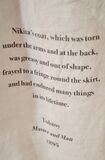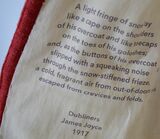Marx's Coat
Karl Marx, revolutionary philosopher and economist, developed his theory of value in his magnum opus Das Kapital. A coat made from ten yards of linen, a symbol of warmth and protection, and a staple of everyman’s wardrobe, was used as the initial commodity in the process of exchange. Yet Marx and his family were living in straightened circumstances in London, and his own coat was regularly pawned, limiting his access to the reading room at the British Museum where Das Kapital was written.
Marx’s Coat is a frock-coat is made from coarse red linen, and constructed using a contemporary pattern. The coat is wired to suggest welcome or perhaps envelopment, and the lining of the coat is printed with cultural references to the symbolism of the overcoat: Protection, disguise, aspiration, comfort. Marx’s quotation from Das Kapital is contrasted with the economist Adam Smith, who used the woollen coat of the day labourer to demonstrate his theory of the division of labour. In Gogol’s The Overcoat, Akaky Akakievich’s desire for a new coat symbolises both basic human need and aspiration, while in Dicken’s Oliver Twist, Fagin’s greatcoat is his disguise and protection. Poet W.B. Yeats uses a tattered coat to deputize for an old man in Sailing to Byzantium, and in Tolstoys Master and Man Nikita’s coat is a metaphor for endurance. The lining of Marx’s Coat also includes some traditional English proverbs that refer to false illusion: ‘It is not the fine coat that makes the fine gentleman’, (1732), and privation: ‘He who has but one coat cannot lend it’ (1706).
Marx’s Coat is a frock-coat is made from coarse red linen, and constructed using a contemporary pattern. The coat is wired to suggest welcome or perhaps envelopment, and the lining of the coat is printed with cultural references to the symbolism of the overcoat: Protection, disguise, aspiration, comfort. Marx’s quotation from Das Kapital is contrasted with the economist Adam Smith, who used the woollen coat of the day labourer to demonstrate his theory of the division of labour. In Gogol’s The Overcoat, Akaky Akakievich’s desire for a new coat symbolises both basic human need and aspiration, while in Dicken’s Oliver Twist, Fagin’s greatcoat is his disguise and protection. Poet W.B. Yeats uses a tattered coat to deputize for an old man in Sailing to Byzantium, and in Tolstoys Master and Man Nikita’s coat is a metaphor for endurance. The lining of Marx’s Coat also includes some traditional English proverbs that refer to false illusion: ‘It is not the fine coat that makes the fine gentleman’, (1732), and privation: ‘He who has but one coat cannot lend it’ (1706).








